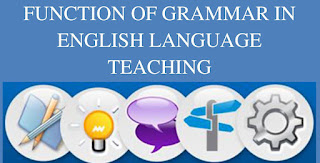THE ROLE OF GRAMMAR IN ENGLISH LANGUAGE TEACHING
FUNCTION OF GRAMMAR IN ENGLISH LANGUAGE
TEACHING
The value of grammar in foreign / second
language teaching has been a focus of debate for many decades, and no
conclusion is in sight still and needs to further analyze.
The expected answer to whether grammar should be taught and to what extent grammar should be taught depends on some variables in the language teaching/learning context, such as learner variables and instructional variables.
There
are two conflicting views regarding the function of grammar:
1. Scientific
view: According to this view the function of grammar is merely to describe the
main characteristics of current usage. It is said that grammatical property is nothing more than the established usage of a particular body of speakers at a
particular time in their history. That is to say, correct usage is not fixed
for all times, and the function of grammar is merely to describe the main
characteristics of current usage. It considers grammar to be a descriptive
science. This may be styled as the natural view.
2.
Logical View: which consider grammar to
be an art more than a science? The rules of grammar are static, subject to no
change. Hazlitt said: “The common method of teaching English grammar by transferring
the artificial rules of other languages to our own occasions much trouble and
perplexity. It is likely to give rise to the usual superstition that theoretical
instruction in grammar is the best way to teach learners how to express
themselves correctly. But it should be borne in mind that grammar does n`t
confer upon the child the power of expression. Hence, it isn`t an end in itself
it is a means to an end and that end is the learning of correct English wit
proper understanding”.
TYPES
OF GRAMMAR
There
are two types of grammar:
1. Formal (Theoretical)grammar
2. Functional (pure) grammar
Formal
or theoretical grammar: Formal or theoretical grammar lays emphasis on form
rather than on application, on definitions rather than their applications. This
type of grammar is for the teacher. In order to add to his scholarship he
should acquaint himself with its science, theory and growth. The knowledge of
rules and generalizations gives him an insight into the structure of the
language. While making corrections he stands on a sure footing, since he can
reason out the stand that he takes. Formal grammar is learnt consciously by
observation and deduction.
Functional
(pure) grammar: Functional (pure) grammar is assimilated unconsciously since it
is inherent in correct usage. It functions in correct speech. This is mainly
for the student who acquires correct usage by imitation. This is the practical
aspect of grammar or the parts of a sentence, in the practical use of language.
It does n`t lay down a set of dogmatic rules to be rigidly followed. It conceives of English grammar as the
grammar of a living language., ‘something developing under the continual
fluctuations and undulations’. It shifts the emphasis from the form of the word
to its function in a particular context. Functional grammar primarily implies
that part of grammar which directly helps the leaner in learning to speak, read
and write English. It enables him to gain a practical command of the language. Whatever
the learner learns he is expected to make use of it immediately in oral and
written work.
Grammar
is used only as a means to an end, the end being the practical command of English.
A school boy studies it for the light it throws on sentence types, and only in
so far as it does so. The grammarian studies if for its own sake, as an end in
itself and as an independent pursuit of knowledge. His aim is scientific. The aim
of a schoolboy is mainly practical, in so far as it illumines his path in
understanding the construction of a sentence. The rules and generalizations of
grammar have no intrinsic worth of their own and don`t confer upon him the
power of expression.
HOW
MUCH GRAMMAR IS TAUGHT?
The
following are the topics in grammar that a high school student is expected to
know:
1. Identification and recall of parts of speech on the basis of their forms and functions in utterance.
2. Knowledge of tenses and models
3. Knowledge of the non-finite; infinitives, gerunds and participles.
4. Identification of different kinds of phrases and clauses conditional, relative, coordinate etc.
5. Recognition of parts of a sentence-subject, predicate, modifier, object, complement etc.
6. Knowledge of different kinds of sentences simple, compound and complex.
7. Ability to analyses, transform and synthesize sentences.
8. Knowledge of punctuation.





Comments
Post a Comment